Department for Transport data used for low-traffic schemes revised down
The schemes restrict through-traffic in residential streets to make them quieter and safer.

Your support helps us to tell the story
From reproductive rights to climate change to Big Tech, The Independent is on the ground when the story is developing. Whether it's investigating the financials of Elon Musk's pro-Trump PAC or producing our latest documentary, 'The A Word', which shines a light on the American women fighting for reproductive rights, we know how important it is to parse out the facts from the messaging.
At such a critical moment in US history, we need reporters on the ground. Your donation allows us to keep sending journalists to speak to both sides of the story.
The Independent is trusted by Americans across the entire political spectrum. And unlike many other quality news outlets, we choose not to lock Americans out of our reporting and analysis with paywalls. We believe quality journalism should be available to everyone, paid for by those who can afford it.
Your support makes all the difference.The Department for Transport has admitted road traffic figures were lower than previously published data which was used to justify low-traffic neighbourhoods (LTNs).
Designed to encourage cycling and walking by limiting driving in residential streets, LTNs were introduced by the Government in 2020 with £225 million in emergency funding.
They include segregated cycle lanes, wider pavements and closing roads to motor traffic.
A spokesperson for the Department for Transport said: “The figures used at the time were based on the most accurate data available.”
All schemes are judged on their individual merits and decisions about their implementation are based on a range of data, including local traffic counts... and collision statistics
The admission comes after a review this week of the report used to justify the use of LTNs found the department had significantly over-counted the increase in traffic on residential streets between 2009 and 2019.
The minor-road traffic estimates report cited figures suggesting an almost 60% rise in London’s minor road traffic and a 72% increase on its smallest roads.
But there had been no increase over the decade, according to the review.
Previously published figures showed a 26% increase in minor road traffic across the whole country between 2009 and 2019, but on revision the increase was 10%, the report said.
The review said “areas for improvement” in how the estimates were reached have been implemented, including in the handling of GPS data.
“As a result, historic minor road traffic estimates have been revised and are lower than those previously published,” the report, published on Wednesday, said.
Transport for London confirmed it was reviewing the data update.
A spokesman said: “All schemes are judged on their individual merits and decisions about their implementation are based on a range of data, including local traffic counts… and collision statistics.”
Opponents claim LTNs make congestion worse, and they have been successful in convincing some local authorities to suspended or downgrade projects.
Tory-led Wandsworth Council said it had suspended its trial scheme after two weeks in September 2020 due to it causing “chaos” and “excessive amounts of pollution”.
But polling by YouGov for Greenpeace UK just a month later, which quizzed 2,027 British adults about their views on transport in their local area, found the majority of people (57%) supported low traffic neighbourhoods and only 16% opposed them.